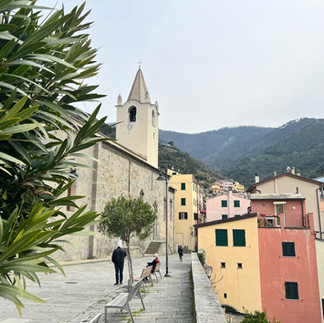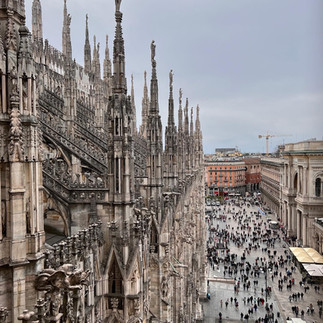
We were fortunate to escape to Italy for 11-day in this past spring. It was SO WONDERFUL to be able to travel again. No, the pandemic is not yet done, but we’re finally in a place where it’s more about managing risk than continuing to isolate. We started to make our trip plans 5-6 months earlier and crossed our fingers we’d be able to go. We felt incredibly lucky that it all worked out.

We traveled with another couple, best friends Curt and Jordan. This was not our first rodeo with these friends, as we’ve traveled with them on numerous milestone birthday trips within the US but this was our first overseas adventure with them. Jordan had not been to Italy before, so one of the goals of our trip with to see a few different sides of Italy—from major tourist cities like Florence and Milan to foodie city Bologna, to smaller Tuscan city Lucca, to the magnificent Cinque Terre. And in all cases, our goal was to enjoy the amazing FOOD! Part of the impetus for us to get this trip on the books was watching Stanley Tucci’s Searching for Italy. The sites, the stories, and the food shown on the show tapped into our wanderlust and we knew it was time to go to Italy again.
11-Day Itinerary for Italy:
Day 1: leave MSP early evening
Day 2: Arrive at Malpensa airport (Milan) around 11 am. Train to Milan Centrale, then train to Bologna. Birthday dinner and stay in Bologna
Day 3: Explore Bologna
Day 4: Leave early morning and head to Florence for most of the day. Late afternoon, take the train to Lucca.
Day 5: Explore Lucca.
Day 6: Train to Cinque Terre. Explore Riomaggiore first, then head to Manarola where we stayed for the next 4 nights.
Day 7: Cinque Terre- explore Monterossa
Day 8: Cinque Terre- Vernazza and then hike Vernazza to Monterossa
Day 9: Day trip to Levanto
Day 10: Train to Milan, explore for the day, then head to the airport for the hotel.
Day 11: Travel day home.
Without the travel days, the pace was 2-2-4-1. Staying for more than one night is often needed for Airbnbs, which was our preferred booking method for lodging.
Is there anything we would change?
Unfortunately, the weather in the Cinque Terre was a bit on the rainy side, so our itinerary worked out just right for getting a few hikes in. If the weather was more cooperative, I might have traded a day in the Cinque Terre for another day in Bologna or Lucca. And, the Florence day trip ended up on Sunday, which made for a very busy city.
An 11-day trip really translates into a 9-days for sightseeing, which is the bare minimum for a trip abroad in my opinion. It would have been great to eke out an additional day or two.
Kevin lived in Milan for a year and we’d both been there before. We’d also been to Florence several times. Although the bigger cities (Venice, Rome, Florence, and Milan) are the most likely places for tourists to go, and they have some amazing sights to see, the real soul of Italy is in the smaller cities. We strive to visit places with fewer tourists and that usually means places outside of the “big 4”.
We will have more in-depth posts on each of these areas shortly, but here is a summary of why we picked these destinations and highlights. I’m including some pronunciations, as in researching for our trip, I watched numerous YouTube travel vlogs where the vloggers mispronounced the names. It’s not that hard, folks!

Bologna
(pronounce this bo-LO-nya and NOT ba-LO-nee or ba-LO-nia)
This really beautiful city is not always on people’s radar when touring around Italy. One of the reasons is it is not in Rick Steve’s Italy book. I think that is a blessing, as it’s widely overlooked, which means fewer tourists (yeah!).
Bologna’s nicknames are La Dotta (the learned one), La Grassa (the fat one), and La Rossa (the red one). Bologna has the oldest continuously operating university in the western world with the students bringing intense energy to the city. Bologna is often called Italy’s culinary capital - the location in the heart of Emilia Romagna, you will find fresh pasta, tortellini, Bolognese sauce, tigelle, and other wonderful culinary delights in this foodie city. And finally, La Rossa - I’ve found two separate meanings, with the simplest one being the red tile roofs that dominate the city. The second meaning is regarding politics with the city having a history as a stronghold of the Italian Communist party.
The city is also famous for its porticoes or portici in Italian. These are colonnades that line the streets, providing shelter for pedestrians. The longest portico in the world is Portico di San Luca, At over 3.5 kilometers long, this arcade connects the sanctuary of Madonna di San Luca with the city center to protect a relic that is transported from the sanctuary to the city center yearly.

Florence (in English), Firenze (in Italian)
(pronounce fee-ren-dze)
Florence is one of the “big 4” cities and for most folks, it’s a must-see. Capital of the Tuscany region, Florence is the birthplace of the Renaissance and home to many iconic sites and artistic masterpieces of the Western world. If you only have a day, pick a museum (we went to the Accademia to see David’s Michelangelo), visit the Duomo and museum, stroll along the Arno River over to Oltrarno, hike up to Piazzale Michelangelo for an amazing view and stop by 1 or 2 markets and churches.
Be ready to share this amazing city with a ton of tourists! Florence is crowded seemingly any time of the year and can be hard to navigate through the throngs of tourists choking the city center. Prepare yourself for lines and crowds. You can eliminate some of the hassles by pre-booking entry tickets ahead of time (sometimes weeks or months in advance is required). The crowds lessen in the evenings so do yourself a favor and take a post-dinner stroll through the streets and along the Arno river.
Before this last Florence visit, my mantra was “there is no bad gelato in Italy” but alas, beware of the very expensive (10 euro a scoop) bad vegan gelato along Via Dei Calzaiuoli. Sigh. Back to the basics:
check the google (or other) reviews and have some places in mind before succumbing to the impulse gelato stop
understand the price
there may be a good reason the place doesn’t have a line.
If you are a Renaissance art lover, stay a couple of days and explore the many museums. The Uffizi Gallery is worth several hours, the Bargello has wonderful sculptures, and the Accademia Gallery not only has Michelangelo’s David, but his wonderful unfinished sculptures where the figures are escaping from the stone. The Boboli Gardens are beautiful and there are many more museums with just as wonderful treasures. Some of the less visited but well worth your time museums include Palazzo Vecchio, the Pitti Palace, Museo San Marco, Cappelle Medicee, and the Museo dell'Opera del Duomo.

Lucca
(pronounced loo-kuh)
Located in Tuscany, Lucca is a wonderful smaller-scaled city with well-preserved medieval city walls that encircle the city. Everything is very walkable within the city walls and you don’t have to deal with any traffic beyond the morning delivery trucks. Lucca is often overlooked by those traveling to Pisa, but it’s an easy side trip if you are heading to Pisa.
Piazza dell Anfiteatro is a gorgeous piazza that was once a Roman Amphitheatre with the elliptical shape still very much intact. Grab a spritz at one of the many restaurants and bars and soak in the atmosphere, and make sure to walk around the outside to see how the houses were built within the structure of the ancient amphitheater.
We had a focaccia picnic along the walls of the city as we enjoyed the sun and people-watching (non-tourists). You can rent a bike to travel around the city on top of the walls - or walk. We only stayed here 2 nights and would have liked to have added a day onto our time here to spend more time exploring.

Cinque Terre
(pronounced cheen-kweh teh-rreh). Note that it is not ter-rah and it’s not spelled Terra, which autocorrect is determined to make it)
Odds are, you have seen pictures of the Cinque Terre villages on jigsaw puzzles or on Instagram. Pastel-colored buildings clinging to the cliff edges overlooking the fishing boats dotting the azure blue sea. This place is the definition of “instagrammable”. The dramatic coastal scenery of the five villages was on the top of my bucket list. And it’s on A LOT of people’s bucket lists, so you need to plan carefully if you’re like us and hate crowds.
Some people just pop into the villages for quick day trips and other people stay longer to do some of the hikes that take you from village to village. We were excited about the hikes and found them challenging because of the vertical inclines - lots of climbing up and climbing down. My knees were glad I did this in my 50s and not in my 60s.
We found that the end of March and beginning of April was a great time – temperature-wise and crowd-wise to go. We were a little early in the season so limited restaurants were open but we found great meals everywhere we went. We never had issues finding espresso, pastries, happy hour drinks, snacks, or provisions from markets or grocers. We did have some rain on every one of the 4 days we spent here but it didn't curtail our fun. The day after we left, there was measurable snow so you do have to be ready for just about anything in this area in spring. Even though we had rain every day, we also had some sun every day and it does get really warm if the sun is shining and you are on one of the hikes. I think the summer would be miserable because of the heat - but the reward of completing a hike could be a dip in the Ligurian Sea.

Milan (in English) or Milano (in Italian)
(Pronounced Mee-LAH-no)
We only had part of a day in this second-largest city in Italy. Kevin had lived there for a year in the late 1980s, so he was our guide. We had pre-purchased tickets to see the Duomo (and climb the roof), as well as the Last Supper. We left our bags at the deposito bagagli at the train station and walked the city. We first went to see the new buildings at Piazza Alvar Aalto and Piazza Gae Aulenti, visited the Sforza Castle, the Brera neighborhood, the Pinacoteca di Brera museum, and had a quick lunch before our scheduled booking for the Last Supper at Santa Maria delle Grazie. It turns out we had read our entry time incorrectly and were almost an hour late - but they managed to find us a slot in one of the current tours. The now restored painting by Leonardo da Vinci is impressive and is lucky to have survived the bombing that destroyed part of the church and courtyard during World War II.
After our time with the Last Supper we went to visit the Basilica di Sant'Ambrogio, Basilica San Lorenzo Maggiore, and walked through the Navigli neighborhood (canals) before our timed entry ticket to visit the massive Duomo and its rooftops - offering incredible views of the sculpture cathedral itself and the city. There was a demonstration (anti-vax supporters) in the piazza we avoided somewhat, and strolled through the Galleria, had a look at La Scala opera house, and then went to tour the Santuario di San Bernadino alle Ossa (a chapel decorated with skulls and bones). At the end of the day, we took the metro back to the train station, collected our bags, and took the train out to our hotel near Malpensa airport.

Best Time of Year to Travel to Italy
Most of our trips to Italy have been in the spring in either March or April---or in the fall (October, November) in other words, shoulder season. These are ideal times when the weather is a bit cooler, and you can avoid the hot summers and the massive crowds of people. The only downside with shoulder season travel is that not all restaurants are open -but it’s such a minor thing, it doesn’t get in the way of having a fantastic time.
As you might have gathered by now, we don’t do well in very crowded cities or places that attract throngs of tourists. And we discovered on this trip that cities like Florence and Milan were busier than we’ve ever seen them and it was still off-season. We can only imagine how crowded these cities will be in the summer of 2022 and beyond, so if you’re planning an Italian adventure in the upcoming future, you have been warned. It will be extremely busy. That means more planning will be needed with reservations or tickets, as well as even restaurant reservations. I know, I know--- you don’t want to be so pinned down when traveling! But the world had changed, and you can go for spontaneity during travel---but you will sacrifice great lodging and restaurants. For example, we started booking our lodging 5 months before our trip and were able to get amazing places in Bologna, Lucca, and Manarola. My goal for our Cinque Terre lodging was to have a place and balcony with an amazing view and we achieved that by booking early.
We also made restaurant reservations in Bologna, Lucca, and some in the Cinque Terre. I booked through websites or had our Airbnb host contact a restaurant. In Manarola and the Cinque Terre villages, we booked earlier in the day for an evening reservation and that worked well.

The Importance of Spritz O'Clock
We first learned of the Spritz Happy Hour when we were in Venice in 2018. A spritz is a lovely orange drink that consists of Aperol, Prosecco, soda water, and an orange slice. You can't help but notice that the outdoor tables are filled with people enjoying this delicious drink in the late afternoon, often accompanied by small bowls of chips. We found ourselves asking is it "Spritz O'Clock yet?". The answer was always yes and we enjoyed many a spritz on our trip. Usually seated at outdoor tables, sipping this refreshing libation while watching the people, dogs, and cats in the streets or piazzas is a perfectly fine way of soaking in Italian life.
Train or car?
For the cities we were visiting, there is no question that train travel was the preferred way to travel. Train travel is often quicker than by car and you don’t have the hassle of trying to navigate and then find a place to park. Having a car in the cities we visited would have been a major pain in the ass as they were pedestrian-only streets (ZTL zones) in many cases. If your itinerary includes places off the beaten path and avoids large cities, that changes the equation, and a car would be more attractive. We did rent a van for our family when we spent a month in Tuscany at a farmhouse stay. That was the only option for us on that trip.
For train travel, I recommend downloading the Trenitalia app for your phone. It will give you schedules and you can buy tickets ahead of time.

Bottom Line
Italy is a place we will NEVER tire of visiting. With breathtakingly beautiful cities and countryside, delicious food, and signature art and architecture, it’s hard to go wrong with any itinerary. We tend to prefer the smaller, less popular regions to discover what Italy is like beyond the main tourist attractions - and to travel off-season to appreciate the slower pace of the country.



























































